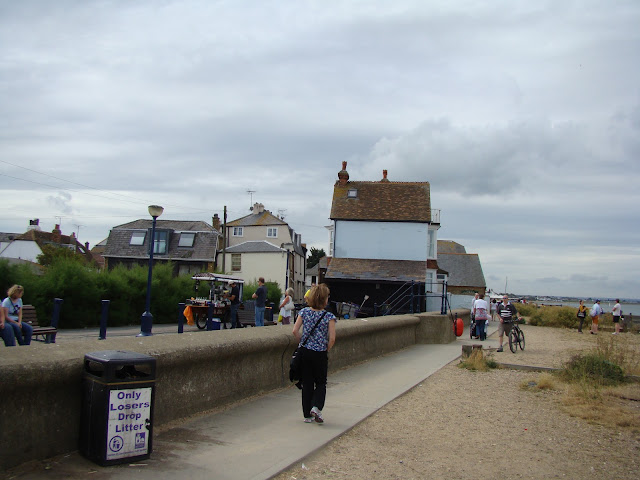Canterbury, UK
We had a 3 day weekend and decided on a trip to the Southeast part of the UK. We stayed in Ashford (a good central location) and travelled out from there. A good trip
Here's a little history introduction to the Canterbury Cathedral
In 597 AD, Pope Gregory sent Augustine to convert King Æthelberht of Kent to Christianity. After the conversion, Canterbury, as a Roman town, was chosen by Augustine as the centre for an episcopal see in Kent, and an abbey and cathedral were built. Augustine thus became the first Archbishop of Canterbury.[9] The town's new importance led to its revival, and trades developed in pottery, textiles and leather. By 630, gold coins were being struck at the Canterbury mint.[10] In 672 the Synod of Hertford gave the see of Canterbury authority over the entire English Church.[8]
In 842 and 851, Canterbury suffered great loss of life during Danish raids. In 978, Archbishop Dunstan refounded the abbey built by Augustine, and named it St Augustine's Abbey.[11] A second wave of Danish attacks began in 991, and in 1011 the cathedral was burnt and Archbishop Alphege was killed. Remembering the destruction caused by the Danes, the inhabitants of Canterbury did not resist William the Conqueror's invasion in 1066.[8]William immediately ordered a wooden motte-and-bailey castle to be built by the Roman city wall. In the early 12th century, the castle was rebuilt with stone.[12]
After the murder of Archbishop Thomas Becket at the cathedral in 1170, Canterbury became one of the most notable towns in Europe, as pilgrims from all parts of Christendom came to visit his shrine.[13] This pilgrimage provided the framework for Geoffrey Chaucer's 14th-century collection of stories,The Canterbury Tales.
The Gateway into the Cathedral Area
The Canterbury Tales are a collection of stories were written by Geoffrey Chaucer back in the 14th century as a part of a story telling contest as they travel together on a journey to the shrine of St.Thomas Beckett at Canterbury Cathedral. Most high school students will remember it, not necessarily fondly.
Thomas Becket was the Archbishop of Canterbury when he was murdered due a conflict with King Henry II. He was later venerated as a saint by both the Catholic and Anglican churches and his body laid in rest in the cathedral until King George VIII destroyed it as a part of the dissolution of the monasteries in the late 1500's.
Nave in the Cathedral
THE TOMB OF THE "BLACK PRINCE", Canterbury Cathedral, Kent
Edward, Prince of Wales, (the "Black Prince"), was the eldest son of King Edward III of England. Although he never became king - he died before his father - he is remembered as a great medieval warrior, after victories against the French in The Hundred Years War.
Visit to Dover - Dover Castle and the White Cliffs of Dover
view of the harbor (France in the distance ~ 30 miles away)
One of many ferries that cross the harbour (4-5x/day). 60% of goods still travel by ship or ferry, 40% now use the Chunnel. Note the buses and cars queued for the ferry. Cars and buses travel by day, trucks by night.
Entrance to the Medieval Fort.
I was just born a few centuries too late...
Old church on the site and a Roman Lighthouse beside it.
View from the tower...
After we left the castle, we went looking for the Dover visitors center (in one of the guidebooks) to get a better look at the white cliffs and maybe take a hike to the South Foreland Lighthouse. The visitor parking lot was full so we went further up hill to find additional parking... never found any so we kept going and stumbled across St. Margaret's Bay. Its a small city just northeast of Dover, has a great parking lot right on the water which looks up at the white cliffs. We walked up the hill and found a public footpath for the lighthouse (~ 2 miles?). The cliffs are made of chalk (100,000 years to make 1 cm of chalk) from the remains of a tropical sea on the area millions of years ago. The trail walk was the highlight of the day (you can walk right up the edge of the cliff, if inclined to do so... but they've have landslides (see below).
FILE - This is a Thursday, Feb. 1, 2001. file photo shows the lighthouse on top of the White Cliffs of Dover, England, after a large segment of chalk fell from the cliff after a landslide.
cliffs at low tide.. this areas was underwater when we returned from the lighthouse trek
The cliffs are make of soft chalk..
path from the sea to the lighthouse..
Beautiful scenery.. this was closer than I wanted to get to the edge...
South Foreland Lighthouse
This land (Samphire Hoe County Park, just south of Dover) was reclaimed from the "chalk waste" from digging the chunnel. The sea was up against the cliffs before the reclamation.
Whitstable, UK
We stopped by Whitstable on the way back to Derby.. very fresh seafood and oysters.. You can see the largest sea wind farm under construction in the distance. Worth a couple of hours































Great job Tim - I love history so I appreciate it when the bloggers include a little historical perspective of the places they are visiting. I also have this trip on our "to do" list but it isn't scheduled yet so when we get closer I will be touch to pick you brain.
ReplyDelete